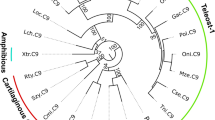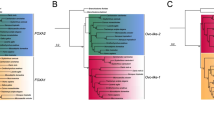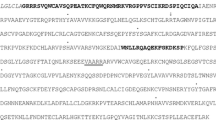Abstract
To elucidate the evolution of the complement system and MHC class III region, we analyzed the complement factor B (Bf) genes of a urochordate ascidian, Ciona intestinalis. Three different cDNA species, termed CiBf-1, CiBf-2 and CiBf-3, were identified. The deduced amino-acid sequences all contained the usual domains of vertebrate Bf and, in addition, three extra domains at the N-terminus. Furthermore, the serine protease domain of these CiBfs shared unique features with vertebrate complement components C1r/s and mannose-binding lectin-associated serine protease (MASP)-2/3, the absence of the disulfide bond designated histidine loop, and the usage of the AGY codon for the catalytic serine residue. These results indicate that complement genes have evolved through extensive exon shuffling events in the early stage of chordate evolution. Overall deduced amino-acid identity between CiBf-1 and -2 was 88%, whereas CiBf-3 showed 49% identity to both CiBf-1 and CiBf-2. These three CiBf genes were located within an approximately 50-kb genomic region, and exons 3 and 5 of all the three Bf genes showed an extremely high degree of nucleotide identity, indicating that the CiBf genes experienced extensive reorganization, such as duplication and gene conversion, since its divergence from the vertebrate Bf/C2 gene. Fluorescent in situ hybridization (FISH) to the chromosomes showed that genetic loci for the CiBfs, CiC3-1 and CiC3-2 genes are present on three different chromosomes, suggesting the possibility that the linkage among the MHC class III complement genes was established in the vertebrate lineage after its divergence from urochordates.





Similar content being viewed by others
References
Ambrus G, Gal P, Kojima M, Szilagyi K, Balczer J, Antal J, Graf L, Laich A, Moffatt BE, Schwaeble W, Sim RB, Zavodszky P (2003) Natural substrates and inhibitors of mannan-binding lectin-associated serine protease-1 and -2: a study on recombinant catalytic fragments. J Immunol 170:1374–1382
Aviv H, Leder P (1972) Purification of biologically active globin messenger RNA by chromatography on oligothymidylic acid-cellulose. Proc Natl Acad Sci USA 69:1408–1412
Azumi K, De Santis R, De Tomaso A, Rigoutsos I, Yoshizaki F, Pinto MR, Marino R, Shida K, Ikeda M, Arai M, Inoue Y, Shimizu T, Satoh N, Rokhsar DS, Du Pasquier L, Kasahara M, Satake M, Nonaka M (2003) Genomic analysis of immunity in a Urochordate and the emergence of the vertebrate immune system: “waiting for Godot”. Immunogenetics 55:570–581
Cameron CB, Garey JR, Swalla BJ (2000) Evolution of the chordate body plan: new insights from phylogenetic analyses of deuterostome phyla. Proc Natl Acad Sci USA 97:4469–4474
Chirgwin JM, Przybyla AE, MacDonald RJ, Rutter WJ (1979) Isolation of biologically active ribonucleic acid from sources enriched in ribonuclease. Biochemistry 18:5294–5299
Clow LA, Gross PS, Shih CS, Smith LC (2000) Expression of SpC3, the sea urchin complement component, in response to lipopolysaccharide. Immunogenetics 51:1021–1033
Consortium TMS (1999) Complete sequence and gene map of a human major histocompatibility complex. Nature 401:921–923
Dehal P, Satou Y, Campbell RK, Chapman J, Degnan B, De Tomaso A, Davidson B, Di Gregorio A, Gelpke M, Goodstein DM, Harafuji N, Hastings KE, Ho I, Hotta K, Huang W, Kawashima T, Lemaire P, Martinez D, Meinertzhagen IA, Necula S, Nonaka M, Putnam N, Rash S, Saiga H, Satake M, Terry A, Yamada L, Wang HG, Awazu S, Azumi K, Boore J, Branno M, Chin-Bow S, De Santis R, Doyle S, Francino P, Keys DN, Haga S, Hayashi H, Hino K, Imai KS, Inaba K, Kano S, Kobayashi K, Kobayashi M, Lee BI, Makabe KW, Manohar C, Matassi G, Medina M, Mochizuki Y, Mount S, Morishita T, Miura S, Nakayama A, Nishizaka S, Nomoto H, Ohta F, Oishi K, Rigoutsos I, Sano M, Sasaki A, Sasakura Y, Shoguchi E, Shin-i T, Spagnuolo A, Stainier D, Suzuki MM, Tassy O, Takatori N, Tokuoka M, Yagi K, Yoshizaki F, Wada S, Zhang C, Hyatt PD, Larimer F, Detter C, Doggett N, Glavina T, Hawkins T, Richardson P, Lucas S, Kohara Y, Levine M, Satoh N, Rokhsar DS (2002) The draft genome of Ciona intestinalis: insights into chordate and vertebrate origins. Science 298:2157–2167
Gongora R, Figueroa F, Klein J (1998) Independent duplications of Bf and C3 complement genes in the zebrafish. Scand J Immunol 48:651–658
Holland LZ, Gibson-Brown JJ (2003) The Ciona intestinalis genome: when the constraints are off. Bioessays 25:529–532
Ishiguro H, Kobayashi K, Suzuki M, Titani K, Tomonaga S, Kurosawa Y (1992) Isolation of a hagfish gene that encodes a complement component. EMBO J 11:829–837
Ji X, Azumi K, Sasaki M, Nonaka M (1997) Ancient origin of the complement lectin pathway revealed by molecular cloning of mannan binding protein-associated serine protease from a urochordate, the Japanese ascidian, Halocynthia roretzi. Proc Natl Acad Sci USA 94:6340–6345
Kasahara M (1999) The chromosomal duplication model of the major histocompatibility complex. Immunol Rev 167:17–32
Kobayashi M, Matsuda M, Asakawa S, Shimizu N, Nagahama Y, Satou Y, Satoh N (2002) Construction of BAC libraries derived from the ascidian Ciona intestinalis. Genes Genet Syst 77:283–285
Kuroda N, Wada H, Naruse K, Simada A, Shima A, Sasaki M, Nonaka M (1996) Molecular cloning and linkage analysis of the Japanese medaka fish complement Bf/C2 gene. Immunogenetics 44:459–467
Marino R, Kimura Y, De Santis R, Lambris JD, Pinto MR (2002) Complement in urochordates: cloning and characterization of two C3-like genes in the ascidian Ciona intestinalis. Immunogenetics 53:1055–1064
Miyazawa S, Azumi K, Nonaka M (2001) Cloning and characterization of integrin alpha subunits from the solitary ascidian, Halocynthia roretzi. J Immunol 166:1710–1715
Miyazawa S, Nonaka M (2004) Characterization of novel ascidian beta integrins as primitive complement receptor subunits. Immunogenetics 55:836–844
Nakao M, Matsumoto M, Nakazawa M, Fujiki K, Yano T (2002) Diversity of complement factor B/C2 in the common carp (Cyprinus carpio): three isotypes of B/C2-A expressed in different tissues. Dev Comp Immunol 26:533–541
Nonaka M, Azumi K, Ji X, Namikawa-Yamada C, Sasaki M, Saiga H, Dodds AW, Sekine H, Homma MK, Matsushita M, Endo Y, Fujita T (1999) Opsonic complement component C3 in the solitary ascidian, Halocynthia roretzi. J Immunol 162:387–391
Nonaka M, Kuroda N, Naruse K, Shima A (1998) Molecular genetics of the complement C3 convertases in lower vertebrates. Immunol Rev 166:59–65
Nonaka M, Miyazawa S (2002) Evolution of the initiating enzymes of the complement system. Genome Biol 3:REVIEWS1001
Nonaka M, Namikawa C, Kato Y, Sasaki M, Salter-Cid L, Flajnik MF (1997) Major histocompatibility complex gene mapping in the amphibian Xenopus implies a primordial organization. Proc Natl Acad Sci USA 94:5789–5791
Nonaka M, Takahashi M (1992) Complete complementary DNA sequence of the third component of complement of lamprey. Implication for the evolution of thioester containing proteins. J Immunol 148:3290–3295
Nonaka M, Takahashi M, Sasaki M (1994) Molecular cloning of a lamprey homologue of the mammalian MHC class III gene, complement factor B. J Immunol 152:2263–2269
Nonaka M, Yoshizaki F (2004) Evolution of the complement system. Mol Immunol 40:897–902
Ohno S (1999) Gene duplication and the uniqueness of vertebrate genomes circa 1970–1999. Semin Cell Dev Biol 10:517–522
Saitou N, Nei M (1987) The neighbor-joining method: a new method for reconstructing phylogenetic trees. Mol Biol Evol 4:406–425
Satou Y, Yamada L, Mochizuki Y, Takatori N, Kawashima T, Sasaki A, Hamaguchi M, Awazu S, Yagi K, Sasakura Y, Nakayama A, Ishikawa H, Inaba K, Satoh N (2002) A cDNA resource from the basal chordate Ciona intestinalis. Genesis 33:153–154
Schwartz S, Zhang Z, Frazer KA, Smit A, Riemer C, Bouck J, Gibbs R, Hardison R, Miller W (2000) PipMaker—a web server for aligning two genomic DNA sequences. Genome Res 10:577–586
Sekine H, Kenjo A, Azumi K, Ohi G, Takahashi M, Kasukawa R, Ichikawa N, Nakata M, Mizuochi T, Matsushita M, Endo Y, Fujita T (2001) An ancient lectin-dependent complement system in an ascidian: novel lectin isolated from the plasma of the solitary ascidian, Halocynthia roretzi. J Immunol 167:4504–4510
Shida K, Terajima D, Uchino R, Ikawa S, Ikeda M, Asano K, Watanabe T, Azumi K, Nonaka M, Satou Y, Satoh N, Satake M, Kawazoe Y, Kasuya A (2003) Hemocytes of Ciona intestinalis express multiple genes involved in innate immune host defense. Biochem Biophys Res Commun 302:207–218
Shoguchi E, Ikuta T, Yoshizaki F, Satou Y, Satoh N, Asano K, Saiga H, Nishikata T (2004) Fluorescent in situ hybridization to ascidian chromosomes. Zool Sci 21:153–157
Smith LC, Shih CS, Dachenhausen SG (1998) Coelomocytes express SpBf, a homologue of factor B, the second component in the sea urchin complement system. J Immunol 161:6784–6793
Sunyer JO, Zarkadis I, Sarrias MR, Hansen JD, Lambris JD (1998) Cloning, structure, and function of two rainbow trout Bf molecules. J Immunol 161:4106–4114
Suzuki MM, Satoh N, Nonaka M (2002) C6-like and C3-like molecules from the cephalochordate, amphioxus, suggest a cytolytic complement system in invertebrates. J Mol Evol 54:671–679
Terado T, Okamura K, Ohta Y, Shin DH, Smith SL, Hashimoto K, Takemoto T, Nonaka MI, Kimura H, Flajnik MF, Nonaka M (2003) Molecular cloning of C4 gene and identification of the class III complement region in the shark MHC. J Immunol 171:2461–2466
Thompson JD, Gibson TJ, Plewniak F, Jeanmougin F, Higgins DG (1997) The CLUSTAL_X windows interface: flexible strategies for multiple sequence alignment aided by quality analysis tools. Nucleic Acids Res 25:4876–4882
Volanakis JE (1998) Overview of the complement system. In: Volanakis JE, Frank MM (eds) The human complement system in health and disease. Marcel Dekker, New York, pp 9–32
Volanakis JE, Arlaud GJ (1998) Complement enzymes. In: Volanakis JE, Frank MM (eds) The human complement system in health and disease. Marcel Dekker, New York, pp 49–81
Wada H, Satoh N (1994) Details of the evolutionary history from invertebrates to vertebrates, as deduced from the sequences of 18S rDNA. Proc Natl Acad Sci USA 91:1801–1804
Acknowledgements
We thank Dr. Kaoru Azumi for supplying Ciona hemocyte RNA, Dr. Mari Kobayashi for supplying Ciona BAC clones, Dr. Yuji Kohara for supplying the ciad66f24 clone, Dr. Mariko Kondo for critical reading of the manuscript, Dr. Masanori Taira for allowing us to use the microscope, Mr. Tetsuro Ikuta and Dr. Hidetoshi Saiga for giving instruction in FISH technique, and the staff of the Misaki Marine Biological Station for supplying and keeping ascidians. This work was supported by grant no. 15207019 to M.N. from the Ministry of Education, Culture, Sports, Science and Technology of Japan
Author information
Authors and Affiliations
Corresponding author
Additional information
The sequences reported in this paper have been deposited in the DDBJ database (accession nos. AB180044–AB180051).
Rights and permissions
About this article
Cite this article
Yoshizaki, F.Y., Ikawa, S., Satake, M. et al. Structure and the evolutionary implication of the triplicated complement factor B genes of a urochordate ascidian, Ciona intestinalis. Immunogenetics 56, 930–942 (2005). https://doi.org/10.1007/s00251-004-0752-4
Received:
Revised:
Published:
Issue Date:
DOI: https://doi.org/10.1007/s00251-004-0752-4




